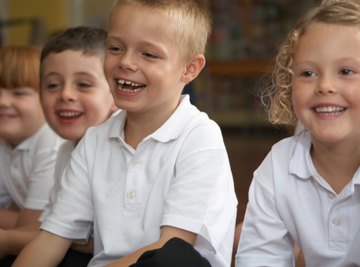
Science experiments are an effective way to get kids interested in science and keep them engaged in the learning process. Fourth graders are just beginning to take themselves seriously as scholars. They're asking more questions, and are ready to build on the foundations from the previous grades, however, they still require active engagement. Science experiments are a proven way to keep 4th grade students interested and help them make connections between science and the world around them.
Goo Yuck: An Exploration in States of Matter
Known by many names and requiring only basic household ingredients, the Goo Yuck experiment is one that kids can really get into -- literally. To perform this experiment, you will need one box of cornstarch and 1 to 2 cups of water. Gradually mix the cornstarch and water together until the mixture reaches the consistency of honey. You can add a small amount of food coloring to give the mixture more character. The resulting mixture ,Goo Yuck, defies Isaac Newton's laws of viscosity. Have students play with the mixture, and observe how it reacts to different amounts of pressure. When dormant it will appear liquid, and when tapped or squeezed it will appear as a solid.
Dancing Raisins: Density and Buoyancy
This experiment, uses matter in all three of its forms (solid, liquid, and gas) to illustrate density and buoyancy. It requires raisins, fresh club soda, and a large clear glass. Pour the club soda into the glass, and gradually add several raisins. The raisins will first sink to the bottom of the glass. Carbon dioxide bubbles will then attach themselves to the textured surface of the raisins and push them up to the surface. When the carbon dioxide bubbles reach the surface they release their gas into the air, and the raisins will sink again, repeating the cycle and creating the dancing raisins effect.
Human Planets: The Solar System
The vastness of the solar system can be a hard concept to grasp, and this experiment puts it in a scale the children can comprehend. You will need nine children and a large field. Decide upon a scale that converts steps to millions of miles, for example, one step equals 36 million miles. Assign a planet to each child , including the sun. Have each child take the appropriate number of steps away from the sun to represent the distance between the respective planets and the sun. Use this as an opportunity to discuss the size of the solar system and the amount of time it takes to travel through space.
Tricking Your Tastebuds: The Wonderful Sense of Smell
The human sense of smell is responsible for most of what people taste. This experiment will give kids firsthand experience with how their sense of smell is related to their ability to taste food. Materials for this experiment include:
- apple slices
- cotton balls
- vanilla extract
- mint extract
- vinegar
Have each child take a bite of apple, taking note of the taste. Then have each child take a bite of apple and chew while you hold a cotton ball with vanilla extract near her nose. Repeat with the peppermint extract and vinegar. After each experiment have the children discuss how the apple tasted different in relationship to the smell of the cotton ball.
References
About the Author
Based in Norfolk, Va., Ashley Berkman has been a freelance writer for LexisNexis since February 2010. Specializing in Web content, Berkman has contributed to numerous websites for private law offices. She holds a Bachelor of Arts degree in theater and communications from Old Dominion University and is currently pursuing a second degree in multimedia design.
Photo Credits
Ableimages/Photodisc/Getty Images
